

|
China's unprecedented rate of urbanization is opening up a wealth of commercial opportunities for European businesses and institutions that possess technology and expertise developed in the continent's own urbanization process. Ranging from skills needed to develop China's fast-expanding built environment to social needs such as education and training, European businesses and institutions across the board are set to benefit. [more] |
|
Timeline of China's urbanization March 2006 Urbanization continues to be a key strategy in the 11th Five-Year Plan (2006-10), with increasing emphasis on reducing energy consumption and carbon emissions, and reducing the rural-urban divide. March 2011 The 12th Five-Year Plan (2011-15) sets targets to accommodate growing urban population by developing 36 million units of affordable housing. February 2012 Launch of the EU-China Partnership on Urbanization, a government-led project to encourage sharing of expertise and technology between EU and Chinese officials and businesses on urbanization. March 2013 Premier Li Keqiang tells the annual session of national legislators and political advisers that a people-focused "new type of urbanization" will facilitate better integration of migrant workers into urban society and encourage development. |
 |

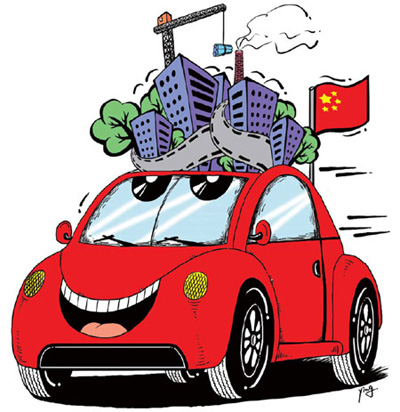 |
Parag Khanna and JT Singh: Chinese cities show up on the global radar And the most effective "New China" model of all views the vast nation through its cities, and understands China not as one big country but rather as a network of dynamic urban economies. [more] |
|
Shen Wei: The daunting challenges of urbanizaiton |
|
|
Louis Kuijs: New way needed to more labor |

|
|
|
|
China's rapidly expanding cities are generating immense opportunities for Europe's masters of planning, architecture and engineering, and attracting the interest of investors and academics. With a home market in which new construction projects are thin on the ground, what particularly attracts European companies to China are the opportunities due to the speed, scale, and room for creativity in construction. [more] |
|
 |
Urbanization has become the midwife of invention China's rapidly growing built environment is inspiring urban planners to develop new ways of thinking. This is because Europe industrialized early and the environmental impact of the built environment was sometimes not properly considered, whereas China's newly built cities have the advantage of learning from Europe's mistakes. [more] |
||
|
Founded in 1947 in the English county of Nottinghamshire specializing in farm buildings, Benoy has come a long way to win flagship projects in China such as Elements shopping mall in Hong Kong and Raffles City in Shenzhen. |
BioRegional has acted as consultant to help the Chinese developer imbed sustainability measures into a new mixed-use development comprising 8,000 homes, known as Jinshan, near the city of Guangzhou. |
Schmidt Hammer Lassen Architects of Denmark is now working on a project in Shanghai in which the materials proposed for a facade have an advanced coating that cleans the air around the building. |
Kazia Li Design Collaborative in the US has developed a planning framework for its architects called DEEP, which stands for four factors needed to achieve sustainability design, environment, economics and planning. |
| What they say | |||
|
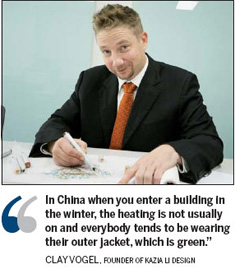 |
 |
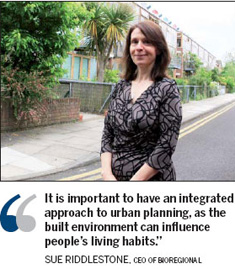 |
 |
| Low carbon and clean technology | ||||
|
An increasing amount of energy needed to fuel China's urbanization has caused serious concerns about carbon emissions and environmental pollution, but also opened up a market for some of the best clean-technology companies in Europe. China overtook the US as the world's largest producer of carbon emissions in 2007, and two years later its energy consumption also surpassed that of the US to become the largest. [more] |
||||
|
 |
German know-how brought to bear in region devastated by earthquake A school with about 3,000 students in the small city of Mianyang, Sichuan province, has become host to some of the world's most energy-efficient construction technologies. Mianyang Experimental Primary School has installed solar panels, double-glazed windows, soundproof doors, energy-efficient cooling and lighting, and many other technologies. [more] |
|||
|
Ricardo-AEA, with extensive experience advising the British and other European governments on achieving emission reductions targets, is keen to help the Chinese government do the same. |
British engineering company Mahle Powertrain has found a market helping China reduce emissions. It has worked with many Chinese automotive companies to develop energy-efficient engines. |
Bureau of International Recycling (BIR) works to encourage best industrial practices in recycling so that the environmental impact of economic development is kept to a minimum. |
The Carbon Trust, which the British government founded in 2001, set up a representative office in China in 2009, the first international market it ventured into. [more] |
|
|
|
|||
|
China's rapid urbanization has provided an ideal market for the world's pioneering technologies on urban solutions to develop and commercialize in the country before being launched globally. Research and development work relating to the development of eco-cities, smart cities and clean energy by foreign companies is booming in China, due to large market demand and government policy support. [more] |
|||
|
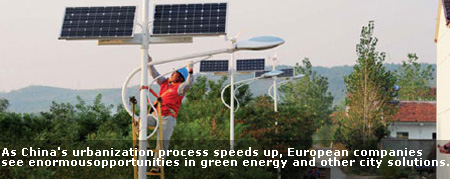 |
Humans at the center of the urban maze Heavier emphasis on science in architecture will improve the way China's urbanization works, British expert says. Scientific research will become increasingly important as the emphasis in urbanization in China is put on quality rather than quantity, an urban planner says. [more] |
||
|
Sweden's Envac Environmental Technology Co Ltd uses large, underground pneumatic tubes to distribute waste to a centralized processing facility in Tianjin. |
Arup, a UK-headquartered engineering consultancy, is currently trialing innovative energy-efficient building solutions in Hong Kong, which is a potential market for China's eco-cities. |
British company Green Biologics says that working with Chinese biobutanol plants has helped to validate its technology. |
Architectural company ZEDfactory Ltd, which has developed a solar panel, jointly with the Chinese company Himin. |
|
|
|||
|
Though China's rapid urbanization is putting a huge strain on the country's healthcare resources, it is also creating opportunities for foreign healthcare providers to sell products and services or provide training for their Chinese counterparts. A rapid influx of population into urban centers has meant that cities are unable to provide adequate services in an orderly manner to all citizens, while an imbalance of funding in China's rural areas has resulted in poor healthcare services. [more] |
|||
|
 |
Big pharma takes the road less traveled for big gains in China China's dream of universal healthcare by 2020 is expected to create huge opportunities for foreign healthcare companies in rural China. Many foreign healthcare companies expect the informal collaboration to develop into actual revenue-sharing agreements in the future. [more] |
||
|
Denmark-headquartered pharmaceutical company Novo Nordisk entered the Chinese market in 1994, with a focus on diabetes treatment. To expand its footprint in rural China, the company has invested heavily in training rural doctors on diabetes treatment. |
With the Beijing-based Intech Rehabilitation Hospital as a partner, Swedish Healthcare has recently designed a course that focuses on the management of start-up nursing homes and rehabilitation clinics for the Chinese market. |
US pharmaceutical giantPfizer has launched 50 drugs designed for the Chinese market so far, and plans to introduce more. |
French pharmaceutical company Sanofi has sought expansion into rural China by establishing a business unit dedicated to China's county -level markets. |
| Education and training | |||
|
In China, migrant workers are flooding into city centers to provide an abundant labor pool. According to data provided by the National Bureau of Statistics, in 2012, China had about 262 million migrant workers, an increase of 37 million from 2008. However, as China shifts gears to more high-tech and service industries, migrant workers will also need to upgrade their skills. With established vocational training systems at home, many German and British education providers and government departments have been keen to share their experiences with China. They often set up training organizations in partnership with Chinese companies or government departments. They also work closely with European manufacturing and advanced engineering companies in China, who require highly skilled technicians that are familiar with working in an international corporate culture. [more] |
|||
 |
European companies help to improve China's high-tech talent pool A lack of skilled technicians in China has prompted many Western businesses to set up their own training centers in China. This process is playing a significant role in helping China's labor force move up the skills-value chain, and furthering development of high-tech industries. [more] |
||
|
Tianjin Sino-German Vocational Technical College, established in 1985 as a partnership between the Chinese and German governments, offering courses in electro-mechanical specialties, languages, economic management and art design. |
Warwickshire College expanded into China in 2012, with the launch of China-UK National Skills College, aiming to provide British style vocational education, which places emphasis on hands on experience and entrepreneurship. |
In 2007, the German engineering and electronics company Bosch introduced an apprenticeship scheme to improve the skills of its Chinese employees. |
Shanghai Kaijian Huazhan Senior Care Service Co is a senior care home that provides training classes for its nurses. |
| Consumption | |||
|
Increasing sophistication is walking hand in hand with urbanization to retail counters all around China. As well as creating millions more consumers with rising incomes, rapid urban expansion is also creating far more demanding and discriminating consumers, and in the process, creating new opportunities for foreign brands. Foreign companies have great advantages in China, as they are often supported by brand reputation and heritage, especially in areas where quality is important to the Chinese consumer, such as luxury products and food. [more] |
|||
|
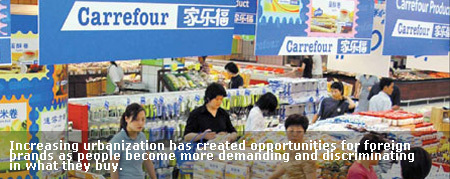 |
Getting it right on site Big or small, all of China's cities are growing - but how and where to locate a new business is a major challenge. Choosing locations is easy in the US, because people typically travel by car and urban development is slow. But in Chinese cities, the exact location of where you put your stores makes a huge difference. [more] |
||
|
Retail chains such as Wal-Mart, from the US, Carrefour of France, and the UK's Tesco moved in and have expanded in China with global expertise in management as their key advantage. |
The Chicago-based Dover Corporation first came to China in 1991 to provide services for industrial products and focuses more today on printing services for consumer products such as food, beverages, cosmetics, and personal care and pharmaceutical products. |
Britain's folding bike, the Brompton, has embarked on a sturdy little trail across China hoping to provide a convenient commuting and recreation option for the country's upwardly mobile urban population. [more] |
British technology company Dyson only entered China last November, opening stores in Beijing and Shanghai to sell vacuum cleaners, hand driers, and bladeless fans and heaters. |
| Culture and entertainment | |||
|
Higher income levels and more leisure time among urban dwellers are spawning a growing demand for art and entertainment activities in China. Though diversified art and entertainment products have long been an established industry in developed nations, it is the resurgent demand as a result of the rapid urbanization in China that is now proving to be an irresistible draw for Western companies. [more] |
|||
|
 |
Urbanization opens doors for foreign players in art, entertainment sectors China's urbanization is creating an increasingly affluent middle class keen on art and entertainment activities. This has also been helped by the growth of entertainment facilities in urban centers like cinemas and theme parks, which would not have been economical in the less concentrated rural areas.[more] |
||
|
In the live performance sector, many globally renowned companies have already staged shows in China. Chinese urban residents have enjoyed many live performances from overseas, including The Mousetrap, the London Philharmonic Orchestra, the London Symphony Orchestra, and musicals including Mamma Mia, Cats, and Notre Dame de Paris. |
China's TV and film industries provide great opportunities for foreign companies whose creative content and production expertise are well liked by the Chinese audience. One such example is The Voice of China, which is produced in the same format as The Voice of Holland, created by Talpa TV. Talpa TV subsequently sold the China production rights to Star Media, and helped it produce a version for the Chinese audience in the same format and the same quality of the original. |
Tourism is also experiencing a growth, as urbanization has increased consumers' curiosity of the outside world. China's expenditure on travel abroad totaled $102 billion last year, the highest globally. |
China's urban art scene has also grown over the years, to host many prestigious international art shows, fairs, galleries and auction houses. Meanwhile, urban China is witnessing an increasing number of foreign-themed entertainment venues and attractions, like theme parks, zoos and aquariums. |